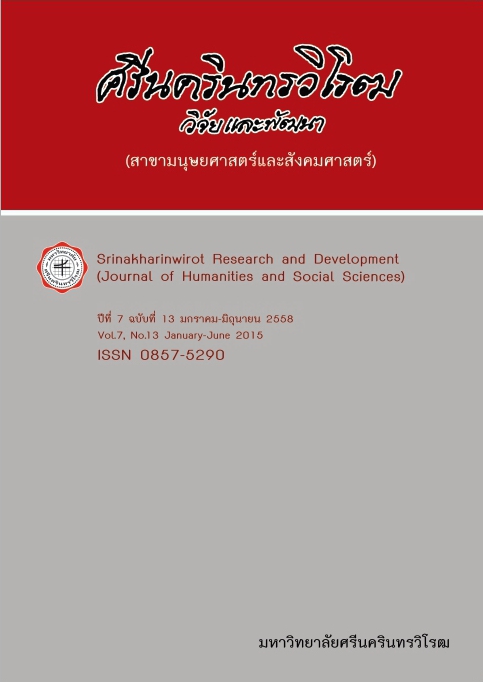การยอมรับและพฤติกรรมของผู้บริโภคต่อผลิตภัณฑ์ชาสมุนไพรไทย CONSUMER ACCEPTANCE AND BEHAVIOR TOWARD THAI HERBAL TEA PRODUCTS
Keywords:
การยอมรับ พฤติกรรมผู้บริโภค ผลิตภัณฑ์ชาสมุนไพรไทย วิเคราะห์ปัจจัย วิเคราะห์ลอจิสติกส์Abstract
บทคัดย่อ
งานวิจัยครั้งนี้เป็นการวิจัยเชิงสำรวจมีวัตถุประสงค์ เพื่อศึกษาการยอมรับและพฤติกรรมผู้บริโภค
ต่อผลิตภัณฑ์ชาสมุนไพรไทย และศึกษาปัจจัยสำคัญที่มีผลต่อการบริโภค กลุ่มตัวอย่างคือผู้บริโภคคนไทยที่ให้ความสำคัญกับสุขภาพและเป็นผู้ที่เคยบริโภคชา หรือชาสมุนไพร โดยการเลือกตัวอย่างกระจายตามพื้นที่ 4 ภูมิภาคของประเทศไทยได้แก่ ภาคกลางที่กรุงเทพ-ปริมณฑล ภาคเหนือที่จังหวัดเชียงใหม่ ภาคตะวันออกเฉียงเหนือที่จังหวัดขอนแก่นและภาคใต้ที่จังหวัดสงขลา รวมทั้งหมด 448 คน โดยใช้แบบสอบถามร่วมกับการสัมภาษณ์และทดสอบ
การยอมรับของผู้บริโภคต่อผลิตภัณฑ์ชาสมุนไพรไทยชนิดซองชง 6 ชนิดได้แก่ ชาใบหม่อน ชาขิง ชาดอกคำฝอย
ชาเจียวกู้หลาน ชามะขามแขก และชาเขียว โดยวิธีการทดสอบความชอบแบบ Hedonic scaling 9 point
ผลการวิจัยพบว่ากลุ่มตัวอย่างชอบดื่ม ชาเขียว/ชาญี่ปุ่นมากที่สุด รองลงมาเป็น ชาจีน ส่วนใหญ่ความถี่การดื่มชา 1 – 3 ครั้ง/สัปดาห์ และน้อยกว่า 1 ครั้ง/สัปดาห์ ส่วนสถานที่ที่ซื้อชาบ่อยที่สุด คือ ห้างสรรพสินค้า/ซุปเปอร์มาร์เก็ต รองลงมาเป็นร้านสะดวกซื้อ ทั้งนี้ผู้บริโภคมีวัตถุประสงค์ เพื่อเป็นเครื่องดื่มทั่วไป รองลงมาเป็นเพื่อบำรุงสุขภาพ โดยชอบดื่มในช่วงเวลาเช้ามากที่สุด รองลงมา คือช่วงเวลาบ่าย จากผลการวิเคราะห์ปัจจัย
โดยการสกัดปัจจัยวิธี Principle Component Analysis ได้กลุ่มปัจจัยใหม่ 3 ปัจจัย เรียงลำดับตามความสำคัญ
คือ ปัจจัยที่ 1 ด้านค่านิยมของสังคม ปัจจัยที่ 2 ปัจจัยด้านสุขภาพและปัจจัยที่ 3 ปัจจัยด้านคุณภาพผลิตภัณฑ์
ผลทดสอบการยอมรับของผู้บริโภคต่อชาสมุนไพรไทย พบว่า ชามะขามแขกมีคะแนนความชอบมากที่สุดทั้งด้านความชอบโดยรวม ด้านกลิ่น ด้านรสชาติ ด้านกลิ่นรสสมุนไพรและความรู้สึกหลังกลืน รองลงมาผู้บริโภคชอบชาขิง แต่ชาเจียวกู้หลานได้คะแนนความชอบต่ำสุดอย่างมีนัยสำคัญ ขณะที่คุณลักษณะสีของชาทุกชนิดมีคะแนนความชอบไม่แตกต่างกันทางสถิติโดยมีความชอบระหว่าง 6.3-6.5 จากผลการวิเคราะห์คุณลักษณะของชาที่มีผลต่อการยอมรับและการตัดสินใจซื้อผลิตภัณฑ์ประเภทชาของผู้บริโภค โดยใช้สถิติ Logistic regression analysis พบว่า ทั้ง สี กลิ่น รสชาติ กลิ่นสมุนไพรในชา และความรู้สึกหลังกลืน เป็นคุณลักษณะสำคัญของชาที่มีผลต่อการยอมรับและการตัดสินใจซื้อผลิตภัณฑ์ชาของผู้บริโภค โดยความรู้สึกหลังกลืน มีความสำคัญมากที่สุด ดังนั้น ผู้ผลิตชาสมุนไพรไทยแบบชง ควรเน้นคุณลักษณะเฉพาะสมุนไพร ในด้านความรู้สึกหลังกลืน รสชาติ กลิ่นรสสมุนไพรในชาและสี เป็นสำคัญและควรแสดงข้อมูลเชิงวิชาการในเรื่องความปลอดภัย
และสรรพคุณให้ชัดเจน เพราะผู้บริโภคในประเทศมีกระแสค่านิยมดูแลสุขภาพเชิงป้องกันมากขึ้นและสนใจเครื่องดื่มสมุนไพรเป็นอาหารสุขภาพด้วย
Abstract
The objectives of this survey research were to study the consumers’ acceptance and behaviors towards the Thai herbal tea products, including investigating the important factors affecting the herbal tea consuming. The 448 consumers participated in this study were from 4 regions of Thailand: Bangkok and vicinity representing of the central part of Thailand, Chiangmai the North, Khonkaen the Northeast, and Songlkhla the South. The data were collected by using a questionnaire, an interview and using the Hedonic nine-point scale for acceptance test. The samples were 6 herbal tea products: mulberry tea, ginger tea, safflower tea, Jiaogulan tea, Senna tea, and green tea. The results showed that most consumers preferred green tea or Japanese tea, and Chinese tea, respectively. Most participants drank tea 1-3 times per week and less than once a week. Most consumers bought the tea products from the department store or supermarket, and the convenience store, respectively. The objectives of their consumption were for common drink and for health promotion. They usually drank tea in the morning and in the afternoon, respectively. The results of Factor analysis using Principle Component Analysis indicated 3 factors affecting tea consuming: social value, heath benefit and product quality. The results also showed that Senna tea received the most preference for overall liking scale, aroma, taste, herbal flavor and feeling after taste. The consumers’ second preference was for ginger tea, but the lowest preference was for Jiaogulan tea. However, there was no significant difference on the color of every kind of tea ranging from 6.3 to 6.5. The logistic regression indicated that color, aroma, taste, herbal flavor and feeling after taste affected on consumer acceptance, but only the feeling after taste influenced purchase intention. Herbal tea producers should provide the information about food safety and health benefit because Thai consumers prefer herbal drinks as the health food.Downloads
Downloads
Published
How to Cite
Issue
Section
License
Srinakharinwirot Research and Development Journal of Humanities and Social Sciences is licensed Under a Creative Commons Attribution-NonCommercial-NoDerivs 4.0 International (CC-BY-NC-ND 4.0) License, Unless Otherwise Stated. Please Read Journal Policies Page for More Information on Open Access, Copyright and Permissions.



